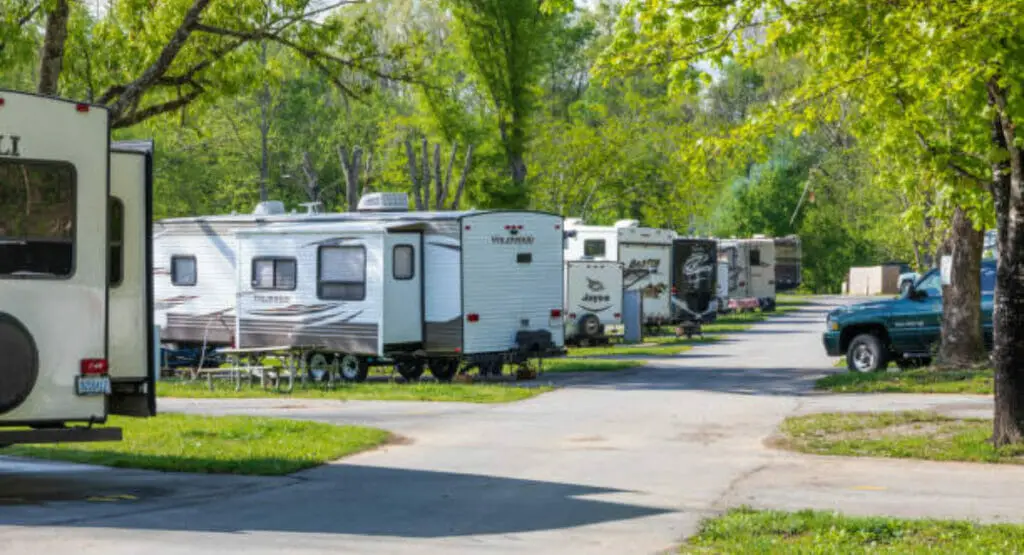It is important to sanitize your RV fresh water tank on a regular basis to ensure that the water inside is safe to drink. Over time, bacteria and other contaminants can build up in the tank, making the water unsafe to consume. Additionally, if the water in the tank tastes or smells strange, it may be a sign that the tank needs to be sanitized.
Sanitizing the tank will help to remove any harmful bacteria or contaminants that may be present, ensuring that the water in the tank is clean and safe to drink. It is especially important to sanitize the tank if you have not used it for an extended period of time, as this can allow bacteria to grow inside the tank.
By following the steps outlined above, you can effectively sanitize your RV fresh water tank and ensure that the water inside is safe to drink.
Materials you need to sanitize your RV fresh water tank
To sanitize an RV fresh water tank, you will need the following materials:
- A mild bleach solution (1 cup of bleach per 15 gallons of water)
- A water hose
- A water tank cleaner (optional)
Here is a step-by-step guide on how to sanitize your RV fresh water
1. Empty and rinse the fresh water tank
Empty and rinse the fresh water tank thoroughly using the water hose to remove any dirt or debris. For that, you will need to follow these steps:
- Locate the valve that controls the flow of water from the tank. This is usually located near the bottom of the tank and maybe a lever or a screw-type valve.
- Attach a water hose to the valve. Make sure the hose is long enough to reach a suitable location for the water to drain, such as a drain or a grassy area.
- Open the valve and allow the water to flow out of the tank and into the hose. The water pressure in the tank should be enough to push the water out through the hose.
- Once the water has stopped flowing, close the valve and remove the hose from the tank.
- Repeat this process until the fresh water tank is completely empty.
- Once the tank has been thoroughly rinsed, it is ready to be sanitized.
It is important to completely empty the fresh water tank before sanitizing it to ensure that all the water in the tank has been treated and the tank is thoroughly clean.
If you’re having difficulties finding these drains in your RV, consult your owner’s manual.
2. Fill the tank with the mild bleach solution. The solution should be made by mixing 1 cup of bleach for every 15 gallons of water.
To fill an RV fresh water tank with a mild bleach solution for sanitization, you will need to follow these steps:
- Calculate the capacity of your freshwater tank. You can usually find this information in the owner’s manual for your RV or by contacting the manufacturer.
- Calculate the amount of bleach solution you will need to fill the tank. To do this, you will need to mix 1 cup of bleach for every 15 gallons of water. For example, if your fresh water tank has a capacity of 50 gallons, you will need to mix 3.3 cups of bleach with 50 gallons of water (1 cup / 15 gallons * 50 gallons = 3.3 cups).
- Fill a large container or bucket with the required amount of water. If you do not have a container large enough to hold all the water, you can fill the tank in stages.
- Add the bleach to the water and mix it well to ensure that it is evenly distributed.
- Attach a water hose to the valve on the freshwater tank. Make sure the hose is long enough to reach the container or bucket with the bleach solution.
- Open the valve and allow the bleach solution to flow into the tank.
- Close the valve once the tank is full.
- Repeat this process if you needed to fill the tank in stages.
It is important to make sure that the bleach solution is mixed correctly and that the tank is filled completely to ensure that it is properly sanitized.
3. Allow the solution to sit in the tank for at least an hour.
After filling an RV fresh water tank with a mild bleach solution for sanitization, it is important to allow the solution to sit in the tank for at least an hour to give it time to work. During this time, you can use the opportunity to clean other parts of the RV.
Here are some tasks you can do while the bleach solution is sitting in the tank:
- Clean the exterior of the RV, including the windows and any external storage compartments.
- Clean the interior of the RV, including the floors, counters, and surfaces.
- Wipe down any appliances, such as the refrigerator, stove, and microwave.
- Disinfect any high-touch areas, such as door handles, light switches, and faucets.
- Vacuum the floors and upholstery to remove any dirt or debris.
By cleaning the RV while the bleach solution is sitting in the tank, you can ensure that the entire vehicle is thoroughly disinfected and ready for use.
4. Drain the bleach solution from the tank and rinse the tank thoroughly with clean water.
After allowing a mild bleach solution to sit in an RV fresh water tank for at least an hour to sanitize it, you will need to drain the solution from the tank and rinse it thoroughly with clean water. Here are the steps you can follow to do this:
- Locate the valve that controls the flow of water from the tank. This is usually located near the bottom of the tank and may be a lever or a screw-type valve.
- Attach a water hose to the valve. Make sure the hose is long enough to reach a suitable location for the water to drain, such as a drain or a grassy area.
- Open the valve and allow the bleach solution to flow out of the tank and into the hose. The water pressure in the tank should be enough to push the solution out through the hose.
- Once the solution has stopped flowing, close the valve and remove the hose from the tank.
- Refill the tank with fresh water and repeat this process several times, emptying and refilling the tank until the water coming out of the hose is clear and free of any bleach residue.
- Once the tank has been thoroughly rinsed, it is ready to be used.
It is important to rinse the tank thoroughly with clean water after using a bleach solution to ensure that all the bleach has been removed and the water in the tank is safe to drink.
- If desired, fill the tank with clean water and add a water tank cleaner. Tank cleaners are chemicals that are specifically designed to remove any remaining dirt or bacteria from the tank.
- Allow the tank to sit for a few hours to allow the cleaner to work.
- Drain the tank and rinse it thoroughly with clean water.
5. Your RV fresh water tank is now sanitized and ready to use.
Once you have followed the steps to empty, rinse, fill with a mild bleach solution, drain, and refill with clean water, your RV fresh water tank should be sanitized and ready to use.
It is important to regularly sanitize your RV’s fresh water tank to ensure that the water inside is safe to drink and free of any harmful bacteria. The frequency with which you need to sanitize the tank will depend on factors such as how often you use the RV and the water quality in the areas you are traveling to.
In addition to sanitizing the tank, it is also important to practice good hygiene when using the RV’s plumbing system. This includes washing your hands frequently, using clean utensils and containers, and properly storing and handling food.
By following these best practices, you can help ensure that your RV’s fresh water tank is clean and safe to use.
Remember to always use caution when handling bleach and other chemicals. Make sure to follow the manufacturer’s instructions for use and handling.
Conclusion
Sanitizing your RV fresh water tank is an important step in maintaining the cleanliness and safety of your water supply. By following these steps, you can effectively remove any harmful bacteria or contaminants that may be present in the tank. It is important to remember to always use caution when handling bleach and other chemicals, and to follow the manufacturer’s instructions for use and handling.



